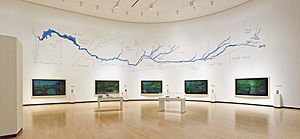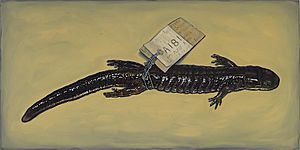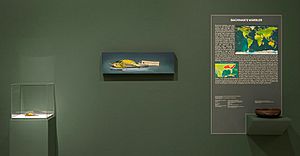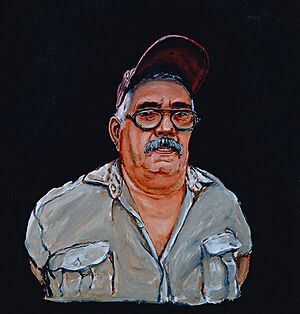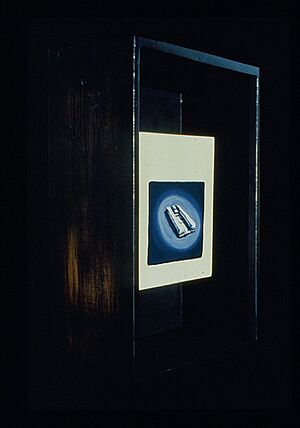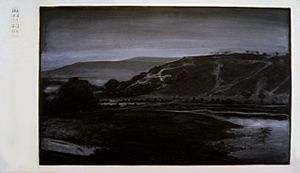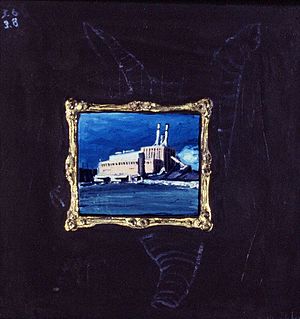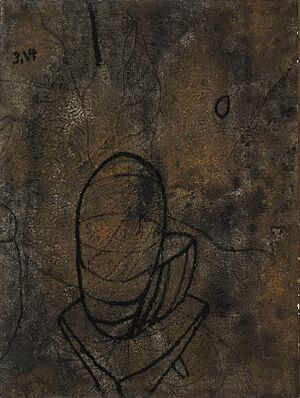Alberto Rey facts for kids
Quick facts for kids
Alberto Rey
|
|
|---|---|

Alberto Rey photographed by David Moog
|
|
| Born | August 7, 1960 Havana, Cuba.
|
| Occupation | Artist and filmmaker |
| Years active | 1988–present |
Alberto Rey (born August 7, 1960, in Havana, Cuba) is a Cuban-American artist, filmmaker, teacher, and writer. His amazing artwork has been shown in over 200 exhibitions and screenings. Many museums, like the Albright–Knox Art Gallery and the Brooklyn Museum, have his art in their permanent collections.
Alberto Rey is a special professor at the State University of New York at Fredonia. In 2012, he was honored by the Burchfield Penney Art Center for his lasting contributions to art. He has also written several books about his art projects, including Candaway Creek - Western New York and Lost Beauty: Icebergs. He has also written articles and created illustrations for magazines like Buffalo Spree and Gray’s Sporting Journal.
In 2021, Alberto Rey gave a video talk about his art. This was part of his big exhibition, Life Streams, at the Ogunquit Museum of American Art. He talked about how his art changed over thirty years and how community projects inspired him. Magazines like Buffalo Spree and The Virginia Sportsman have also written about his work and life. Alberto Rey was even named the 2021 Orvis Fly Fishing Guide of the Year!
Contents
- Alberto Rey's Early Life
- Alberto Rey's Art Career
- Alberto Rey's Art Projects
- Painting Series
- Lost Beauty Project Series (since 2019)
- Biological Regionalism Series (since 2005)
- Bagmati River Art Project Series (2014–2016)
- The Aesthetics of Death Series (2006–2016)
- Trout Encounters Series (2000–2004)
- Studio Retablos Series (1998–2000)
- Cuban Portraits Series (1998–1999)
- Las Balsas (The Rafts) Series (1995-1999)
- Appropriated Memories Series (1996–1997)
- Icon Series (1993–1995)
- Madonnas of Western New York Series (1991–1993)
- Binary Forms Series (1998–1992)
- Black Lace Series and Nuptial Series (1987–1989)
- Autogeographical Series and Floating Series (1985-1987)
- Documentaries
- Painting Series
- Honors and Awards
Alberto Rey's Early Life
Alberto Rey was born into a family of Cubans with Spanish roots, called criollos. His family lived in a small town in Cuba called Agramonte. They had many different jobs, like farming and running small businesses. Alberto's father had a PhD in Math from the University of Havana. Later, when the family moved to the United States, he became a Spanish teacher.
In 1963, when Alberto was three years old, his parents took him and his sister to Mexico to seek political asylum. Two years later, in 1965, they moved to Miami, Florida. After that, his family moved north to a small coal-mining town in Pennsylvania.
Alberto Rey graduated in 1982 with a degree in drawing and painting from the Indiana University of Pennsylvania. In 2008, his university gave him a special award for being a distinguished alumni.
Alberto Rey's Art Career
After college, Alberto Rey worked on the Surrounded Islands Project by famous artists Christo and Jeanne-Claude in Miami. He then went to the University at Buffalo and earned his Master of Fine Arts degree in 1987. After that, he started traveling to many countries, like Spain, Italy, Mexico, and Nepal. These trips helped him appreciate how different cultures connect with their environment.
Since 1982, Alberto Rey's Cuban background and his move to America have shaped his art. He often explores what it means to have a bicultural identity and live in complex places. From 1982 to 1992, his art was more abstract. He layered Cuban symbols with his American experiences. This showed the challenges of fading memories and romanticizing one's culture.
In 1987, the Burchfield Penney Art Center added his painting “Holy Angels Church and Chair” to their collection. He also taught at high schools and colleges, including the Museum of Fine Arts, Boston. In 1988, he studied contemporary art and environmental topics at Harvard University. Soon after, his art was added to El Museo del Barrio in New York City. He also had his first solo show there.
In 1989, Alberto Rey moved to Fredonia, New York to become a professor at the State University of New York at Fredonia. He still teaches drawing and painting there today. By 1992, several major museums, including the Brooklyn Museum and the Albright–Knox Art Gallery, had collected his artwork. From 1992 to 1999, his art became more realistic. He explored Cuban culture, its religion, food, politics, and how it relates to American society.
In 1996, Rey became a director for the Chautauqua Institution’s Center of the Visual Arts. In 1998, he visited Cuba for the first time since he was a child. This trip inspired his first film, "Seeing in the Dark." He also started the SAREP Youth Fly Fishing Program, which teaches kids about protecting the environment. This program is now called Children in the Stream Youth Fly Fishing Program / 4H.
After 1999, Alberto Rey became very interested in art history, ecology, and environmental conservation. He started adding more environmental realism to his art. Since 2000, his work has explored the history of angling art, environmentalism, and biology.
In 2006, Rey started two important programs: the Canadaway Creek Conservation Project and the Brook Trout Restoration Project. The first project involves volunteers cleaning up local waterways, removing harmful plants, and planting native trees. The second project teaches children how to help brook trout grow in local streams. This has helped the trout population grow again.
In 2007, the SUNY board of trustees gave him their highest honor, naming him a SUNY Distinguished Professor for Research and Creativity. In 2012, he was recognized as a Living Legacy Artist by the Burchfield Penney Art Center.
In 2014, the first book about Rey's art, Life Streams: Alberto Rey's Cuban and American Art, was written by art historians.
In 2016, Rey wrote and illustrated a book about his project in Kathmandu, Nepal, called Complexities of Water: Biological Regionalism: Bagmati River, Kathmandu Valley, Nepal. This project studied the Bagmati River, which is very important but also very polluted. The goal was to help people understand how to protect the river and keep their water safe.
In 2018, Alberto published his second book, Extinct Birds Project. This book tells the stories of seventeen bird species from around the world that are now extinct. He painted these birds, and the exhibition included rare audio and video recordings. In 2019, Rey worked with the Anderson Gallery and the Buffalo Museum of Science to create the “Lost Beauty Series.”
Alberto Rey's Art Projects
Painting Series
Critical Endangered Palms of Cuba (2021-2022) This recent series shows palm species in Cuba that are in danger because of soil erosion, farming, and natural disasters. Alberto Rey created ceramic art pieces that show these palms and where they are found in Cuba. This project continues his interest in art that helps protect nature.
Canadaway Creek - Western New York In 2021, Rey released a book about Canadaway Creek. This book was a team effort with students and teachers from State University of New York at Fredonia. It explores the history, plants, animals, and environmental impact of the creek. The project aimed to help people understand the creek and feel responsible for protecting their local environment.
Lost Beauty Project Series (since 2019)
Lost Beauty: Icebergs This series started after Rey's trip to Iceland in 2003. It shows the changing landscape of Jökulsárlón near the Arctic Circle, which is losing ice due to climate change. In 2021, Rey published a book with drawings, paintings, and photos from his trips, along with historical research.
Lost Beauty: Part II - The Art of The Museum Stories Alberto Rey was the first artist asked by the Buffalo Museum of Science to create a special exhibition for them. In the fall of 2021, Part II showed artifacts and specimens from the museum's huge collection. Rey created large paintings, some as tall as six feet, of these items. The exhibit also included stories about the items and videos of his painting process.
Lost Beauty: Part I This project was shown at the Anderson Gallery at the University at Buffalo in the fall of 2019. It featured Rey's paintings and ceramics, along with audio and video files and specimens from his Extinct Birds Project.
Extinct Birds Project Series (2016-2019) In 2018, Alberto published his book Extinct Birds Project. It tells the stories of seventeen extinct bird species from around the world. The initial exhibition opened at the Roger Tory Institute in August 2018, showing 18 paintings of these birds. In 2019, Rey worked with the Anderson Gallery and the Buffalo Museum of Science to create the “Lost Beauty Series.”
Biological Regionalism Series (since 2005)
Biological Regionalism is a way of studying the plants and animals in a specific area. It helps us understand which species belong there and how to protect them. Alberto Rey's Biological Regionalism Series helps people connect with their local environment. He uses images of native fish, landscapes, and water in his paintings, sculptures, and videos.
His work in this series shows fish swimming in their natural homes, sometimes in waters polluted by human activities. By combining his art with his own research, Rey encourages viewers to reconnect with nature. One exhibition, “Biological Regionalism: Scajaquada Creek, Erie County, New York, USA,” showed paintings, videos, and even water samples from the polluted Scajaquada Creek.
Bagmati River Art Project Series (2014–2016)
In 2016, Rey wrote and illustrated a book about his project in Kathmandu, Nepal, called Complexities of Water: Biological Regionalism: Bagmati River, Kathmandu Valley, Nepal. This project collected scientific information about the water quality, pollution, and human impact on the Bagmati River. The goal was to explain how this important river became a health risk and how people can make safer choices for their water supply.
The Aesthetics of Death Series (2006–2016)
After his sister and father-in-law passed away, Rey created this series to explore the topic of death. He painted sick, dying, and dead steelhead fish. He used bright colors and bold brushstrokes to show the contrast between the harshness of death and the temporary beauty of life. The large paintings turn the fish into monuments, capturing a special moment for people to study and think about.
Trout Encounters Series (2000–2004)
After visiting Cuba in 1998, Rey's art changed. He started exploring his passion for environmental conservation and art history. His Trout Encounters series brought together two different worlds: the underwater world of specific trout species and the growing urban communities of people who were losing touch with nature.
Studio Retablos Series (1998–2000)
This series combines different fields like art history, biology, pop culture, and politics. Rey collected old, discarded paintings by amateur artists during his travels. He then gave these paintings new life by removing layers of paint and adding new images from his own journeys. He wondered about the lives of the original artists and felt connected to them through his work.
Cuban Portraits Series (1998–1999)
Rey was inspired by a Mexican portrait painter who documented different groups of people. Rey's series shows Cubans living in Cuba and Cubans living in the United States. He focused on their unique personalities, social class, and ethnic identity.
Las Balsas (The Rafts) Series (1995-1999)
While researching in Key West, Florida, Rey learned about the Cuban Refugee Center. This center helped Cuban immigrants who arrived in Florida on rafts. Rey had relatives who traveled to America on rafts, and his grandmother did not survive the journey. He created this series to make viewers think about what the journey was like for Cuban refugees. The rafts in his art are quiet but strong reminders of human struggles and triumphs.
Appropriated Memories Series (1996–1997)
For many years, Rey's art focused on reconnecting with his Cuban heritage. He also worried about feeling disconnected from his surroundings in America. To understand what was important to him, he painted cherished memories. These included moments with his family, cultural symbols, and images from his childhood in Pennsylvania. This series aimed to capture the feeling of finding and painting images from what he felt was a lost time.
Icon Series (1993–1995)
Rey wanted to reconnect with his Cuban identity, even though he had no actual memories of the country. So, he painted objects and experiences that meant “Cuba” to him, based on stories from his relatives. He painted Cuban food on a large scale, turning everyday dishes into important cultural symbols. An example is “Ancel Guava Paste,” which is now in the Museum of Art in Fort Lauderdale.
Madonnas of Western New York Series (1991–1993)
When Rey lived in Fredonia, NY, he and his wife explored the cultural symbols of Chautauqua County, New York. He built small wooden boxes and painted well-known local symbols, like the Niagara Mohawk Power Plant. This connected his new home to his Cuban heritage and traditions. This series marked a big change in Rey's art style. He started painting more realistically so that people could recognize these local icons and understand their meaning.
Binary Forms Series (1998–1992)
His marriage in 1989 renewed his interest in showing religion and its impact on marriage. His art used symbols to express ideas about marriage, religion, memory, and spirituality. Overlapping shapes represented marriage and memory, while black lace suggested religion. Gold symbolized both marriage and religion.
Black Lace Series and Nuptial Series (1987–1989)
Rey's Black Lace Series was inspired by Catholic rituals and the Cuban religion of Santería. He was fascinated by how items like veils, worn for modesty in church, could also be seen as attractive in other situations. The veil and its lace became important symbols in this series. In his work “Postnuptial Gold: Time,” the color gold represents how precious metal is and refers to Catholic marriage ceremonies.
Autogeographical Series and Floating Series (1985-1987)
The Autogeographical Series was based on Rey's experiences in graduate school and often showed the places he lived. The Floating Series took a more dream-like approach, showing landscapes and cityscapes from a bird's-eye view. This series aimed to show the changing and temporary parts of memory and dreams.
Documentaries
Alberto Rey has also created several documentaries:
- "BAGMATI (Biological Regionalism: Bagmati River, Kathmandu Valley, Nepal)" (2016–2017): This video documents the Bagmati River Art Project. It includes interviews with health experts and community members.
- "Biological Regionalism: Atlantic Cod" (2007): This video explores the history of the Atlantic cod fish and its importance to the economy of New England.
- “Primal Connections” (2006): This video looks at how people in modern times connect with nature.
- “An Unkept Promise” (2005): This video tells the emotional story of Rey's first trip back to Cuba after 36 years.
- “Waters off of Caribarien, Cuba” (2004): This video shows the waters around a small island where many Cubans traveled by raft to Florida.
- “Seeing the Dark” (2001): This film captures Rey's return trip to Cuba and marked a change in his art.
Honors and Awards
Alberto Rey has received many honors and awards for his work:
- Finalist Orvis Guide Freshwater Guide of the Year (2020)
- Visiting Artist at the Masur Museum of Art, Monroe, LA (2012)
- Distinguished Alumni Award at the Indiana University of Pennsylvania (2008)
- Visiting Artist Residency at Peabody Essex Museum, Salem, MA (2008)
- State University of New York Distinguished Professor for Research and Creativity (2007)
- State University of New York Chancellor's Award for Excellence in Scholarship and Creative Activity (2003)
- Kasling Lecturer Award for distinguished scholarly and creative activity (2001)
- William T. and Charlotte N. Hagan Young Scholar/Artist Award (1994)



